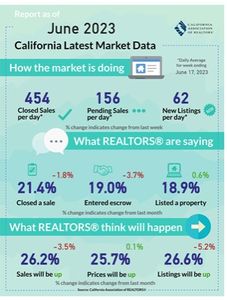 The Federal Reserve met last week and decided to pause rate hikes in their latest FOMC meeting. While the Committee held the fed funds rate steady this time around, Fed Chairman Powell suggested that they are prepared to raise rates a couple more times, or another 50 bps, this year to tame stubborn inflation. Next year, Fed officials see interest rates falling by 100 basis points as economic growth slows further. This is the first time since January 2022 that the Fed made no rate change following a policy meeting. Before the Fed’s announcement, the bond market generally priced in one more 25bps rate increase by the end of 2023. Interest rates have been moving sideways since the announcement but will stay elevated longer than what the market previously anticipated.
The Federal Reserve met last week and decided to pause rate hikes in their latest FOMC meeting. While the Committee held the fed funds rate steady this time around, Fed Chairman Powell suggested that they are prepared to raise rates a couple more times, or another 50 bps, this year to tame stubborn inflation. Next year, Fed officials see interest rates falling by 100 basis points as economic growth slows further. This is the first time since January 2022 that the Fed made no rate change following a policy meeting. Before the Fed’s announcement, the bond market generally priced in one more 25bps rate increase by the end of 2023. Interest rates have been moving sideways since the announcement but will stay elevated longer than what the market previously anticipated.
California housing market back on the upswing: The state housing market bounced back in May after sales dipped back-to-back in March and April. Sales of existing homes in California surged nearly 10% monthly and recorded the highest level in eight months. Mortgage rates reaching the lowest point in two months in early and mid-April might have prompted homebuyers to open escrows then and led to many of these transactions being closed in May. Despite the month-to-month gain, home sales continued to decline by double-digits from the same month of last year. The year-over-year drop in sales was relatively mild compared to recent months and was the lowest yearly decline since June 2022. Through the end of May, sales have declined on a year-to-date basis by 35.1%.
Inflation continues to cool Rates flat after Fed pauses rate hikes: After the initial increase in the run-up to the debt ceiling debate, rates have hovered in the high-6% range and remained there in the wake of the Fed’s decision not to raise their target interest rate at their June FOMC meeting. The weekly Freddie Mac 30-year fixed rate mortgage averaged 6.7% for the week ending June 11th. That is only 2 basis points different from the previous week, and Mortgage News Daily shows average rates at 6.95% at the time of this writing—essentially unchanged from the previous week. However, 10-year Treasuries have begun to rise, so it is possible that mortgage rates will go back above 7%. And with the Fed signaling as many as 2 more rate hikes this year, the return to sub-6% rates is likely to take long than many initially expected.
Mortgage applications probably past seasonal peak: New mortgage purchase applications rose 17% last week, reversing 6 consecutive weekly declines. In addition, the year-to-year declines have begun to slow as applications were down 27% from 2022 levels after averaging 35-40% annual declines for most of the past 6 months. Still, new purchase applications remain relatively depressed, both compared to the pandemic highs as well as much of the pre-pandemic years. And although the limiting factor for homeownership in California currently remains extremely tight inventory, the lackluster buyer demand figures illustrate how rates have impacted purchasing power as well.
California job growth decelerates, but still adding jobs: Although the rate of growth has been slowing in California, the Golden State continue to add jobs in May. Employers added a net of 40,000 new jobs in May after a revised 70,000 increase in April. This puts the year-to-year gains at 2.4%, which is well below the average of 6.4% that persisted during the ‘reopening’ phase of this business cycle. The unemployment rate held steady at 4.5% as signs that the labor shortage continues to thaw slowly. The state’s labor force expanded by more than 25,000 workers last month—most re-entering as unemployed, which prevented the unemployment rate from falling despite a total employment jump of nearly 10,000 in the EDD’s monthly unemployment survey.
General macro indicators remain relatively upbeat, but risks evident below surface: On the surface, many of the macro indicators released last week point to an economy that remains on the upswing. Small businesses were more optimistic in May with the overall index climbing by 5.5% on an annualized basis, but many expect to raise prices in the near future. Manufacturing activity rose slightly last month, but the entire industrial production index fell as mining and utilities declines. Retail sales also rose by more in May than in April, with headline sales up by 1.6% year-to-year. However, in real terms (net of inflation), retail spending has been falling for four months consecutively. The second quarter GDP numbers are likely to remain positive, but growth may be more lackluster as we enter the second half of 2023.
Labor force participation rate remains depressed after early retirements: Despite participation having either nearly or fully recovered to pre-pandemic levels for workers aged 54 and under, the participation rate remains depressed for workers aged 55 and above. During the pandemic, home prices rose dramatically and many long-term homeowners sold their homes and moved closer to family or to desirable destinations and retiring early. This has led to a shortfall in available workers, particularly those with extensive experience, to replace those roles and has kept the labor shortage from shrinking more quickly. It has also caused wages to grow more quickly than they have for much of the past decade, which is one factor keeping inflation from falling faster as well.


